
The proper name for our Sun is Sol, which is why the star system we live in is called the Solar System. It is the Sun that provides the energy source that powers all life on Earth and without it, we wouldn’t exist. However, as far as stars go, the Sun is quite an average star. You can get stars with masses ranging from 0.08 times to 80 times the mass of Sol.
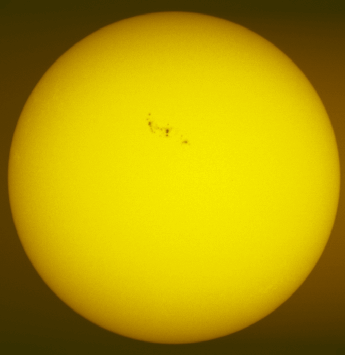
Here’s a typical picture of the Sun. The dark sunspots visible on the Sun surface are cooler regions, with temperatures of around 3800°c. A sunspot can be as large as 2-3 times the diameter of Earth (Source: Royal Swedish Academy of Science).
Sunspots are created as the Sun’s intense magnetic field ‘churns’ up the Sun’s surface but how exactly this happens is not yet fully understood, and is a large area of research for astronomers.
The solar system consists of the Sun at its centre and 8 planets moving in elliptical orbits around it. The Sun is much
larger than the planets. The planets themselves count for less than 0.15% of the mass of the solar system. The planets
are visible only because the light from the Sun reflects off their surface. They don’t emit any light by themselves.
There are also many smaller bodies such as moons orbiting around planets, asteroids and comets.
Earth is the third planet from the Sun. The other planets are named after Greek and Roman gods and goddesses.
They are (as we are moving away from the Sun)
Mercury, named after the Roman god of commerce, travel and thievery.
Venus, named after the Roman goddess of Love because it’s so bright in the sky
Earth, literally named after the dirt or soil it contains. Also referred to by its Latin name, Terra.
Mars, named after the Roman god of war because of its angry red colour.
Jupiter, named after the Roman god. It’s the largest planet in the solar system.
Saturn, named after the Roman god of agriculture. Well known for its beautiful rings.
Uranus, named after the Greek god of the sky. It was the first planet to be discovered using a telescope, and
Neptune, from the Roman god of the sea. Aka 'the blue giant'. It has has 6 rings.
Pluto was considered a planet until 2006, when it was reclassified as a dwarf planet. There are 3 criteria needed to be defined as a planet. The object must orbit its star, have enough gravitational pull to be spherical and have enough mass to clear the area around its orbit. Pluto did not meet the third criteria.
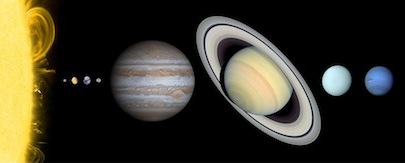
Mercury, Venus, Earth and Mars are all rocky planets. However, despite having that in common,
in other respects these planets differ enormously! Mercury has no atmosphere and as a result it looks a lot like the
Moon, covered in craters produced by countless meteorite impacts. Venus, the second planet from the Sun, is the hottest.
It has an average surface temperature of 464°c, night and day. The highest mountain in the solar system is Olympus Mons on Mars.
It is about three times higher than Mount Everest, the highest mountain on Earth.
On the other hand, Jupiter, Saturn, Uranus and Neptune are gas giants. Jupiter is by far the largest planet of the solar system,
with more mass than all of the other planets put together. It is 300 times more massive than the Earth and has over 60 moons.
Saturn has 9 planetary rings.

The most similar planet to Earth is Mars. There is evidence that water existed on Mars in the past. Features closely resembling shorelines, riverbeds, and islands suggest that great rivers once marked the planet. It is an unsolved problem where this water has gone. Because of the possible existence of water, at least in the distant past, Mars is considered to be a candidate for harbouring (or having harboured) life outside our Earth. ExoMars was a European-led robotic mission to Mars developed by ESA (European Space Agency) and Roscosmos. It launched in 2016 and has deployed several different instruments. The Trace Gas Orbiter (TGO) will orbit Mars looking for methane, which could indicate whether or not there is or was life on the planet. A six wheeled highly-autonomous rover equipped with a camera to take pictures of the surface and a 2m sub-surface drill to collect soil samples unfortunately crashed upon landing.
In the past, most ancient civilisations had some kind of model of the Universe which placed Earth at rest, right at the centre. The Egyptians saw the sky as the body of the goddess Nut, the Hindus saw the sky resting on the tusks of an immense elephant, the Babylonians saw the sky as the inside of a huge bell jar, and the Arabs saw the sky as an immense tent.
Ptolemy (about 100 – 170 A.D), a Roman citizen living in Egypt in the second century A.D., was an astronomer, mathematician and a geographer. He collected and coded a vast quantity of astronomical data and he came up with a model to describe the positions of the planets, which he summarised in his book “The Great Mathematical Composition”.
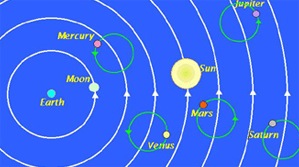
The central statements of his theory are as follows:
In the past, the idea that the Earth was the centre of everything was deeply rooted in everyone’s mind and it was difficult to convince people to believe in anything different. However, there were a few radical thinkers, even as far back as the 3rd century B.C who believed differently. Aristarchos of Samos (about 310 – 230 B.C) believed that the Sun was in fact the true centre of the Universe. At the time, his theory was not accepted and it wasn’t until over a thousand years later that people began to consider it.
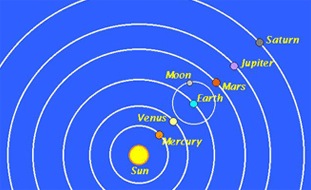
In the Heliocentric System the Sun is in the centre and the planets move in orbits around the Sun. This was something extremely difficult to accept at the time, because it seemed to be opposite to the plausible view that Earth must be the centre of everything.

Kepler discovered the mathematical description of the movement of the planets around the Sun. The so-called Kepler laws were found by detailed inspection of astronomical observations of the planets performed and written down by Tycho Brahe. These laws accurately describe those in mathematical language.
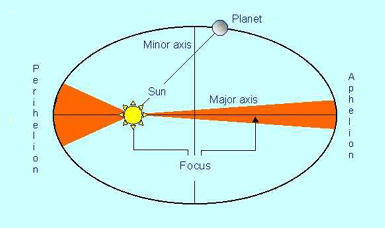
The figure illustrates Kepler’s Laws showing that the orbit of a planet is an ellipse and that the planet sweeps equal areas in equal times (orange areas). Also shown are the major and minor axis and the foci of the ellipse, and the point place in the orbit closest to the Sun (Perihelion) and farthest from the Sun (Aphelion).
Extra-solar planets are planets that orbit other stars. Astronomers are getting more and more adept at finding them and, as of January 2017, around 3447 have been confirmed. It proves that it is quite common for stars to be accompanied by planets. We have already stumbled accross several ones that might have similar properties to Earth. If we found a planet with a similar size, temperature conditions and atmosphere as Earth, then it could be possible that the planet harbours extraterrestrial life.
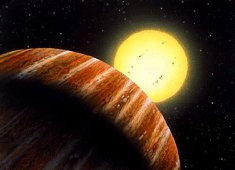
Planets don’t give off their own light, which is what makes them so hard to spot. Furthermore, extra-solar planets are far away so they’re near impossible to see even if we knew where exactly to look. To combat this, astronomers have devised clever ways to see planets indirectly, using the parent star.
For instance, if you’re measuring the light from a star and find that its light dims at regular intervals then it could be because a planet is passing in front of it. However, this method only works if the planet’s orbit takes it through the Earth’s line of sight, which in many cases would not happen. You can also find planets by their gravitational effects. The gravitational effect of the star forces the planets into an orbit around it, but gravity works both ways and the gravitational effect of the planet will be pulling on the star too. It’s not as obvious because the stars are so much bigger and therefore have a much greater gravitational force, but if one measures a star’s position accurately enough, one might see it ‘wobble’ in the sky as the planet pulls at it. The methods astronomers use are most effective when the planets are big, which is why most of the planets we’ve found so far are big gas planets like Jupiter. However, using more and more sophisticated ways astronomers already found several dozen of such planets that are Earth-like and are located in the habitable zone of their stars.
Not all planets have moons. Mercury and Venus, for example, travel alone around the Sun. However, some planets have plenty. Jupiter has over 60 moons. Our planet has just one moon and it is the only place outside Earth that mankind has visited. Astronomers believe that an object roughly the size of Mars collided with Earth and the Moon was formed from the debris.
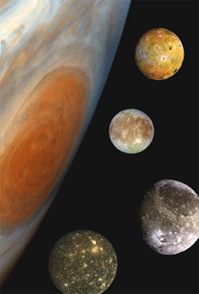
Neil Armstrong became the first man on the Moon on July 21st, 1969, which is an impressive feat considering that the Moon is 384,400km away on average. The Moon is being bombarded with a steady rain of meteoroids, asteroids and comets, as are most planets. While on Earth, falling space objects are usually burnt up in the atmosphere, the Moon is covered in craters because it has no atmosphere.
The battered Moon has a great effect on the Earth. Not only does it control the tides, it also stabilises Earth and reduces the amount that it wobbles on its axis. Without the Moon acting as our anchor, our climate would be extremely unstable and this would reduce the Earth’s ability to harbour life.
Why are Io, Europa, Ganymede and Callisto known as the “Galilean moons” ?
Galileo Galilei (1594 – 1642) was an Italian physicist, mathematician, astronomer and philosopher, considered an extremely important figure in the Scientific Revolution. He is often hailed as ‘The Father of Modern Science’ as he was the first to implement the “experimental scientific method”. Some of his many achievements include constructing the first telescope. With this telescope, he observed the brightest ‘star’ in the sky and found 4 small ‘stars’ orbiting around it, invisible to the naked eye. He soon realised that these bright objects weren’t actually stars at all. He was in fact observing Jupiter and had discovered its 4 largest moons. He named the moons Ganymede, Io, Callisto and Europa but together they’re known as the “Galilean moons” of Jupiter.
Despite making such a huge contribution to science, The Roman Catholic Church didn’t approve of Galileo’s work. In 1633 the Inquisition convicted him of heresy. They forced him to publicly withdraw his support for Copernicus and the heliocentric system and sentenced him to life imprisonment. Due to his advanced age and bad health, that sentence was amended the next day to allow him to serve his sentence under house arrest instead.
Europa is the smallest but the most interesting moon of Jupiter because it is considered a candidate for harbouring extraterrestrial life. It has about a quarter the size of the Earth. It is covered by an ice crust, below which the largest ocean of the whole Solar System is found. It is estimated that this ocean could have a depth of up to 20 km (on Earth the deepest point in all oceans is only about 11 km).
Although the surface temperature of Europa averages -160°c, volcanoes creating hot thermal vents on Europa’s ocean floor could create havens for life. The necessary energy for these volcanoes is provided either by natural radioactive decay (as on Earth) in the rocky interior of Europa or by tidal effects caused by nearby Jupiter.
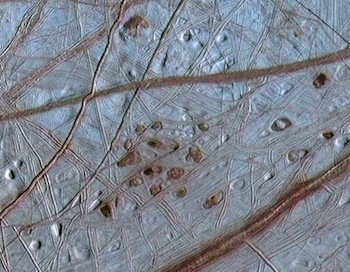
Do tiny algae (or giant squids!) really swim in Europa’s ocean? We do not know yet. The answer depends on the unknown mechanisms for the origin of life itself as well as on the conditions of Europa. A space mission to Jupiter’s moon might provide further clues. For instance, a spacecraft landing on the icy surface of Europa could search for organic molecules produced by life in the ocean. The ice on Europa is too thick for drilling but geologic processes may transport oceanic components to the surface where it could be found by a space probe.
Not only does Europa have what seems to be liquid water, it also has a thin oxygen atmosphere. Yet despite the water and oxygen, living on Europa would still be extremely difficult. The surface receives around 5400mSv (the unit for radiation dose, Sievert, is defined in the chapter Benefits and Risks) of radiation emitted from Jupiter, a fatal dose for humans. One would have to live below the surface, where it is warmer. But then there’s also the much smaller gravitation, yet another health hazard for humans.
There’s often a lot of confusion about the terminology when it comes to the smaller objects that streak across our sky from time to time. So, here are some definitions:

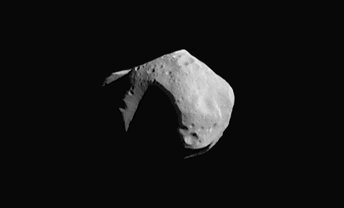
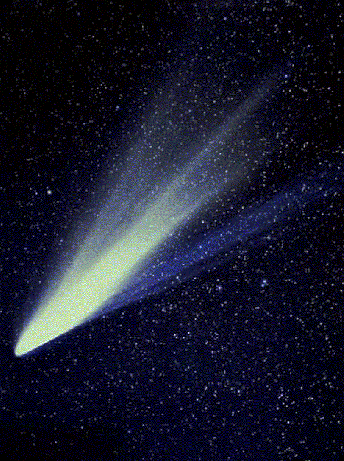
Asteroids are bigger. They can have sizes up to many kilometres. Most of them can be found in the main asteroid belt which orbits the Sun between Mars and Jupiter.
Comets are between 1km and 20km long and are mainly made up of ice and dust. This is why sometimes they can be called 'dirty snowballs'. They have extremely elliptical orbits and, because of this, they spend most of their time far out in the Solar system, beyond Pluto. However, when they get close to the Sun, they’re heated up and the ice melts and evaporates leaving a tail of gas behind. You can often see two tails on a comet. One is made of dust and shows you its direction of travel and one will always face away from the Sun as it’s made of gas which is ripped off the comet’s surface by the solar wind.
The top picture shows a meteorite, called EETA 79001, found on the ice in Antarctica. It quite likely originated from Mars. The cube shown has 1cm sides. (Source: LPI/NASA). The middle image shows part of the asteroid Mathilde about 59 by 47 km across. The surface exhibits many large craters (Source: JHU/APL/NASA). The third picture is of comet West. The thin blue tail is made of gases and the broad white tail is made of microscopic dust particles (Source: John Laborde).
These small rocky or icy objects collide with other objects in the solar system on a fairly regular basis. You can probably tell if you looked at a picture of all the craters on our Moon or the planet Mercury. Fortunately, we have something they don’t have. Earth has an atmosphere.
Usually the objects that collide with Earth are small. As they travel through the atmosphere, the friction they create generates a lot of heat and the object burns up and disintegrates. Sometimes a small fragment might make it through but it’ll probably hit the ground or oceans without hurting anyone.
However, very rarely, a large asteroid or comet will hit the planet and the atmosphere won’t be able to protect us. For example, it’s believed that 56 million years ago, an asteroid about 10km wide hit the Earth in Central America causing earthquakes, huge fires and gigantic tsunamis. The impact threw up ash and debris into the air which blocked out the sun for months, lowering global temperatures to freezing. It’s thought that over two thirds of the species on Earth were killed by this event, including the dinosaurs. However, while scientists know for sure that this asteroid collided with Earth, there’s also some evidence that it may have just been one of many reasons for the extinction of dinosaurs. Fossil records show that the numbers of dinosaurs were already declining quite significantly before the impact and perhaps the asteroid just finished them off.
But what about us? What would happen if an asteroid hit the Earth today?
It would depend mostly on how big it was. If it was the size of a house, it could flatten concrete buildings half a mile from the impact point.
Yet an asteroid a mile wide would cause far more damage, like the one that may have wiped out the dinosaurs. But as scary as all this may
seem, the chances of colliding with an asteroid of that kind of scale are very low, perhaps one large asteroid every 100 million years or so.
You usually don’t find stars all on their own. A galaxy is a collection of an enormous number of stars that are all gravitationally bound to each other. There are a countless number of galaxies. Some are called dwarf galaxies, containing ten million or so stars, 500 times smaller than our own galaxy. Some are unimaginably big, 20 times bigger than our galaxy and containing literally trillions of stars.
Despite this enormous range, most galaxies form into similar patterns so you can catorgorise galaxies fairly easily. The most used classification scheme was invented by the American astronomer Edwin Hubble in 1936. Hubble identified three main types of galaxies based on their visible appearance.
Ellipticals are galaxies that are roughly elliptical in shape and usually consist of older, low-mass stars and have a very low number of new stars forming.
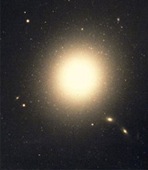
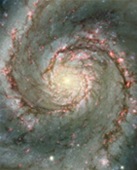
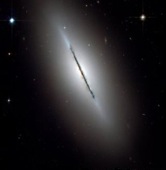
Spiral galaxies are much more common then ellipticals. They consist of a fairly flat, rotating disk of stars that generally form spiral structures and a central concentration of stars called the bulge. The arms tend to be younger, hotter stars with high rates of new star formation whereas the central bulge holds slightly older stars. Many of these galaxies have a central bar of stars in the centre
Lenticulars are somewhere in the middle. They usually contain disks like the spiral galaxies but they are much less well defined and fewer new stars are created. It’s as if the material in the disk had simply been used up and all that’s left is dust. They tend to have much larger bulges too and contain much older stars, more like the elliptical galaxies.
Hubble also identified a fourth catergory. The irregulars. These are galaxies that don’t fit into the other catorgories as they don’t have a well-defined shape. It is thought that these are galaxies that used to have a defined shape but were distorted by the gravity of another large object.We are located within a galaxy called the Milky Way. It is a spiral galaxy containing approximately 200 - 400 billion stars, that
stretches across 100 000 light-years. Our Sun is just one single such star in our Milky Way.
Our Sun is just one of the stars in our galaxy, located about two thirds out from the centre in
one of its spiral arms.
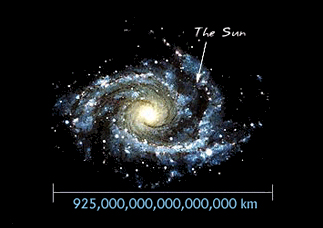
Drawing of the Milky Way showing its spiral form with the approximate location of our Sun (Source: HEASARC/NASA)
The expression Milky Way has two meanings. On one side it is the name of our home galaxy as described before. On the other side it is the dim band you can see in the night sky. In Greek myth, the Milky Way was caused by milk spilt by Hera when suckling Heracle.
Almost all the stars you can see in the sky at night with the naked eye belong to our galaxy. The dim band called Milky Way arises because we are looking towards the centre of our galaxy, towards the bulge. The higher concentration of stars is what makes this region so much brighter.
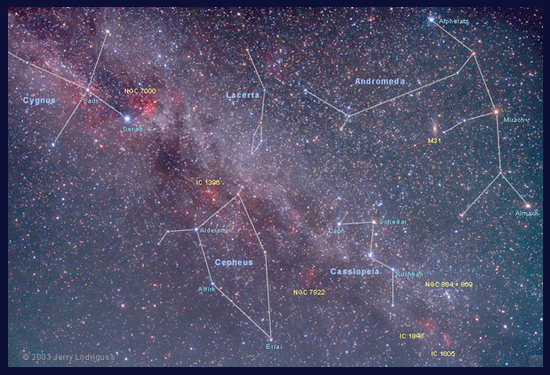
The space between the stars is not empty. Huge clouds consisting of dust and gas can be found. This is called interstellar medium, meaning the stuff between the stars.
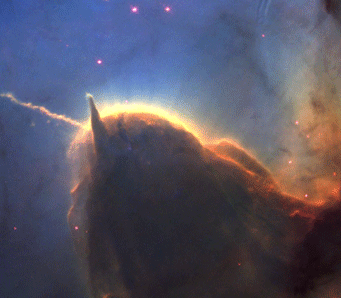
On 25 August 2012, Voyager 1 had reached the interstellar medium, becoming the first manmade object to do so. Voyager 1 will study interstellar plasma and dust until the mission’s end in 2025.
The picture shows a huge interstellar gas and dust cloud in the Trifid Nebula (Source: Arizona State University)
Like stars, galaxies can be gravitationally bound together as well. If there are less than 50 galaxies then it is said that the galaxies are part of a galaxy group. Our galaxy, the Milky Way is part of the Local group, which contains over 30 galaxies. The biggest galaxy in the group (we’re second) is the Andromeda, which is big enough to be seen with the naked eye as a blurry spot in the Northern sky.
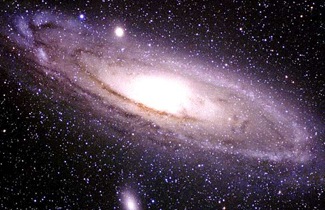
Not all the galaxies in the group are like ours. Two of the much smaller galaxies are satellite galaxies orbiting the Milky Way and are known as the Large and Small Magellanic clouds.
If there are more than 50 galaxies grouped together, they are in what’s called a galaxy cluster. Clusters can have thousands of galaxies all travelling together. Sometimes clusters can combine to form superclusters. Superclusters are so big that they are no longer gravitationally bound. They can form huge walls of galaxies spanning hundreds of millions of light-years. One of these extraordinary walls is called the Great Wall or the Coma Wall. It’s size is 300 million by 500 million light-years across, with a thickness of 15 million light-years.
In astronomy, the scales needed are often extremely big and so sometimes new units are needed. A light-year represents how far light can travel in a year:
1 light-year (ly) = 9.461 x 1015 m
Another unit is the parsec:
1 parsec (pc) = 3.26 light-year (ly)
For very large distances kilo-parsec and Mega-parsec are customarily used:
1 kilo-parsec (kpc) = 1 000 pc
1 Megaparsec (Mpc) = 1 000 000 pc
You may also find astronomical units (AU). 1 AU is the average distance between the Earth and the Sun:
1 AU = 149.6 x 109 m
1 AU = 4.8481 x 10-6 pc
1 AU = 15.813 x 10-6 ly
Space is big and full of fascinating objects that are just too far away for us to get to. As a result, the majority of what we know about the Universe comes from measuring the radiation the objects emit, such as photons or X-rays.
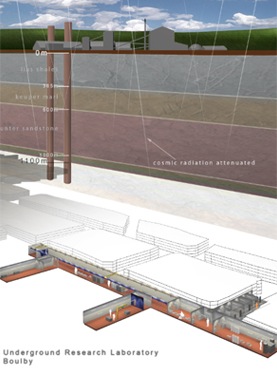
Since then, there have been extensive studies of dark matter. It seems that normal matter, the atoms that make up our Earth, planets, stars and the interstellar medium can only account for 4% of the mass in the Universe. The rest is unexplained.
As we can’t detect dark matter itself, we find it indirectly through the movement of stars in galaxies, and galaxies and dust in clusters. We don’t know what dark matter is made of but there are many theories and experiments working to find out. For example, some scientists believe that dark matter is black holes created in the big bang or brown dwarfs, small cold stars that are too small to burn hydrogen into helium. However, the most commonly accepted theory is that dark matter is made from not yet discovered elementary particles called WIMPs (Weakly Interacting Massive Particles). One of the experiments designed to look for WIMPS is called DRIFT and is located 1100m under the ground at the Boulby mine in North Yorkshire, UK.
